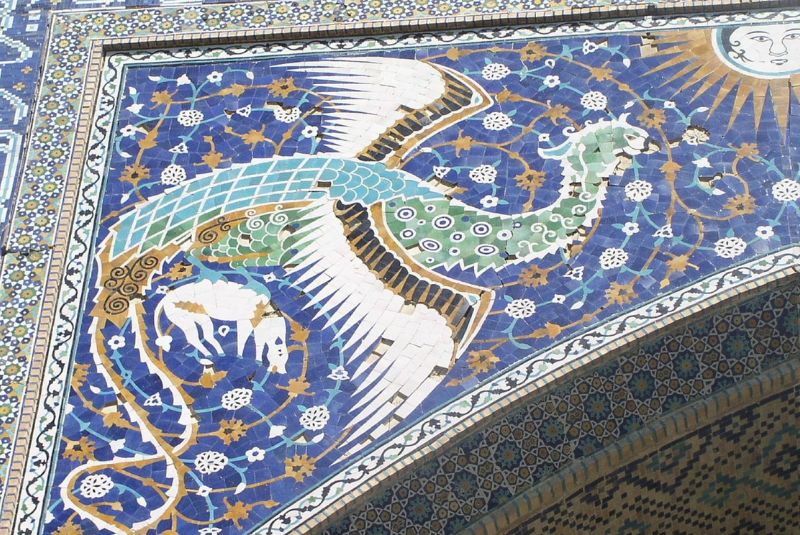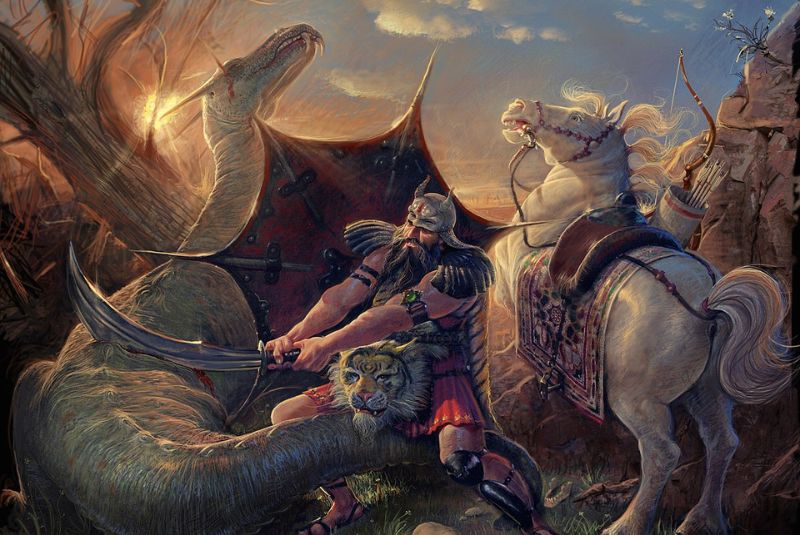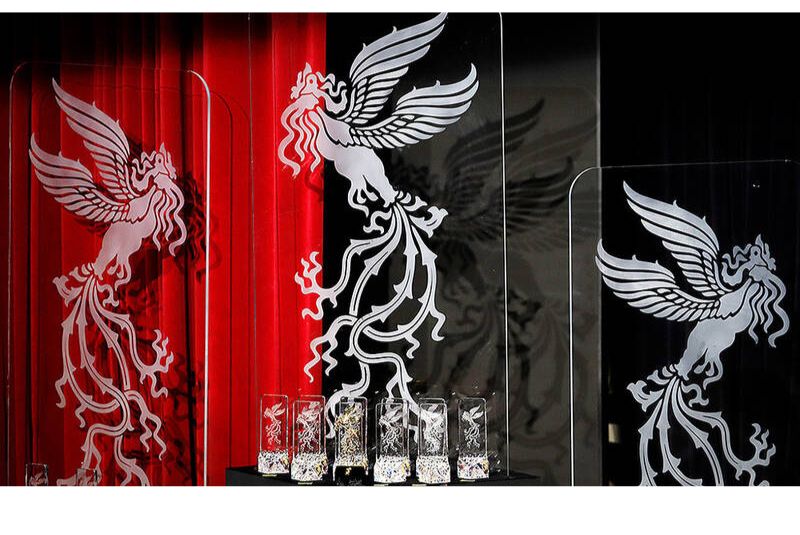The Simurgh | Iran's Mythical Bird | Persian Myth
Have you ever wondered about the mythical creatures that populate the folklore and literature of different cultures? From dragons and unicorns to mermaids and griffins, these fantastical beings have captivated the imagination of people for centuries.
One such creature is the Simurgh, a magnificent bird that originates from Persian mythology. The Simurgh is not only a beautiful and powerful creature, but also a symbol of wisdom, protection, and immortality. In this article, we will explore the origins, significance, appearance, and stories of the Simurgh, as well as its legacy in modern times. If you are planning to visit Iran, you will also find some suggestions on where to discover the traces of this enigmatic creature.
Origin and Significance of Simurgh

The word Simurgh derives from an ancient Persian word and means "30 birds". This could refer to its age (30 centuries), its size (30 meters), or its feathers (30 colors). However, in another interpretation, the word Simurgh does not represent the number 30 in any way; rather, it is a metaphor for a specific number of knowledgeable birds (of unseen events). The Simurgh first appeared in Persian folklore and literature around the 10th century BCE, and has since been featured in many epic poems, tales, and legends. The Simurgh is considered to be the king or queen of all birds, and a benevolent guardian of the natural world. It is also associated with wisdom, as it possesses the knowledge of all ages and languages. Moreover, the Simurgh is a symbol of immortality, as it lives for a very long time and periodically burns itself in fire to renew its youth.
The Simurgh has been represented in various art forms throughout history, including paintings, sculptures, carpets, ceramics, and jewelry. In the realm of mythical creatures, the Simurgh is a striking sight to behold. It is often depicted as a colossal bird with resplendent plumage, a majestic creature that exudes an aura of regal authority. With a head adorned with radiant plumes and a body cloaked in feathers of various colors, this mythical being inspires awe. The Simurgh's image can be found in many historical monuments, religious buildings, royal palaces, and museums in Iran and other countries.
Physical Appearance and Characteristics of Simurgh

As mentioned above, the Simurgh has a unique and majestic appearance. The Simurgh's body is covered with feathers that change color depending on the angle of light. The Simurgh's feathers are also said to have healing properties, as they can cure any disease or wound. The Simurgh's eyes are bright and piercing, and can see through anything. The Simurgh's voice is melodious and enchanting, and can communicate with any creature.
The Simurgh has many supernatural abilities that make it a formidable creature. The Simurgh can fly faster than any other bird, and can travel between different realms of existence. The Simurgh can also manipulate the elements of nature, such as fire, water, wind, and earth. The Simurgh is omniscient, meaning that it knows everything that has happened or will happen in the past, present, and future. The Simurgh is also compassionate and generous, as it often helps those who are in need or seek its guidance.
Legends and Stories Associated with Simurgh

There are many myths or stories involving the Simurgh in Persian culture and literature. One of the most famous ones is its role in the epic poem "Shahnameh" (The Book of Kings), written by the poet Ferdowsi in the 10th century CE. In this poem, the Simurgh rescues an infant prince named Zal from a mountain where his father had abandoned him because of his albino hair. The Simurgh raises Zal as its own child in its nest on Mount Alborz, teaching him all kinds of knowledge and skills. When Zal grows up, he returns to his human family and becomes a great hero and ruler. He also marries a princess named Rudabeh, who gives birth to another legendary hero named Rostam.
Another popular story involving the Simurgh is the tale of "The Conference of the Birds", written by the poet Attar in the 12th century CE. In this story, thousands of birds gather to embark on a journey to find their true king, who is said to be the Simurgh. Along the way, they face many challenges and hardships that test their faith and courage. Only 30 birds manage to reach the end of their quest, where they discover that they themselves are the Simurgh they were looking for.
These tales have influenced Persian culture and literature in many ways. They have inspired many poets, writers, artists, musicians, and philosophers to create works that reflect on the themes of heroism, love, spirituality, identity, and destiny.
Simurgh in Modern Times

The Simurgh has not lost its relevance or appeal in modern times. On the contrary, it has become a symbol of national identity and pride for many Iranians. The Simurgh represents the ancient heritage and cultural diversity of Iran, as well as its resilience and creativity. The Simurgh also embodies the values and aspirations of the Iranian people, such as wisdom, justice, freedom, and peace.
The Simurgh can be seen in various aspects of contemporary Iranian art, fashion, and design. For example, the Simurgh is often used as a motif or logo for books, magazines, films, music albums, clothing brands, jewelry pieces, and other products. The Simurgh is also featured in many public artworks, such as murals, statues, fountains, and gardens. The Simurgh is a source of inspiration and beauty for many Iranians and others who admire its charm and mystery.
The Crystal Simorgh award is a prominent example of how the Simurgh influences modern Iranian culture. This award is given by the Fajr International Film Festival, which is the biggest annual film festival in Iran. The award has different categories for both International and Iranian Cinema Competitions. The award is named after the Simurgh, the mythical Iranian bird.
The Crystal Simorgh award is one of the highest film honors in Iran. It recognizes the best films and filmmakers from Iran and around the world. It celebrates the artistic excellence and diversity of cinema as a medium of expression and communication. It also fosters the dialogue and exchange of ideas among filmmakers and film lovers from different cultures and backgrounds.
The Crystal Simorgh award is a prestigious and coveted prize that attracts many talented and renowned filmmakers to participate in the Fajr International Film Festival. It showcases the latest trends and innovations in cinema as well as the timeless classics and masterpieces. It also reflects the social and political issues and challenges that affect the Iranian society and the world at large.
The Crystal Simorgh award is a symbol of the Simurgh's power and grace as a cultural icon. It highlights how this mythical creature continues to inspire and captivate people's imagination while promoting artistic endeavors that contribute to Iran's cultural landscape.
Visiting Iran to Explore Simurgh's Legacy

If you are interested in learning more about the Simurgh and its legacy in Persian culture, you should definitely visit Iran and explore its rich and diverse attractions. Iran is a country with a long and glorious history, a vibrant and diverse culture, a friendly and hospitable people, and a stunning and varied landscape. Iran has something to offer for every taste and preference, whether you are looking for historical monuments, natural wonders, artistic masterpieces, or culinary delights.
For travelers seeking to explore the enchanting world of the Simurgh, there is no better destination than Iran itself. This remarkable creature is woven into the very essence of the country's cultural heritage. Visitors can discover representations of the Simurgh in architectural details, intricate textiles, beautifully woven carpets, and vibrant paintings, all while immersing themselves in the warmth and hospitality of Iran's people.

There are many destinations where you can find representations or references to the Simurgh in Iran. Here are some suggestions:
- Tehran: The capital city of Iran is a modern metropolis with many cultural and historical attractions. You can visit the National Museum of Iran, where you can see many artifacts that depict the Simurgh in different forms and styles.
- Isfahan: The former capital of Iran during the Safavid dynasty is one of the most beautiful cities in the world. You can visit the Naqsh-e Jahan Square, where you can see the magnificent Sheikh Lotfollah Mosque that has a dome decorated with tiles that resemble the feathers of the Simurgh. You can also visit the Chehel Sotoun Palace, where you can see a mural that depicts the story of Zal and Rudabeh.
- Shiraz: The city of poets and gardens is famous for its literary and artistic heritage. You can visit the tomb of Hafez, one of the greatest Persian poets who wrote many verses about the Simurgh.
- Yazd: The city of windcatchers and Zoroastrians is known for its unique architecture and culture. You can visit the Tower of Silence, where Zoroastrians used to leave their dead bodies to be eaten by birds such as the Simurgh. You can also visit the Fire Temple, where you can see a sacred flame that has been burning for over 1500 years.
Finally!
The Simurgh is one of the most fascinating mythical creatures in Persian mythology. It is a majestic bird that symbolizes wisdom, protection, and immortality. It has been featured in many stories and legends that have influenced Persian culture and literature. It has also been represented in various art forms throughout history and modern times. The Simurgh is a part of Iran's cultural identity and pride.
If you want to discover more about this captivating creature, you should visit Iran and experience its rich cultural heritage. Iran is a country that will surprise you with its beauty and diversity. You will find many places where you can see or learn about the Simurgh in Iran.
We hope this article has sparked your curiosity and interest in the Simurgh and Iran. We invite you to explore this mythical marvel during your travels to Iran. Explore the land of the Simurgh, and let the magic of Persian mythology take flight in your imagination.
Share your story!
Comment below and let us know about your Experience.
Your story inspires others!


Comment
Leave a Comment